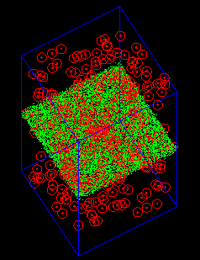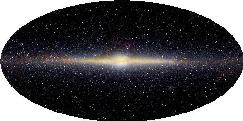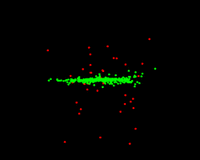Millions of black
holes in the Milky Way dark halo?
Our Milky Way is a
typical spiral galaxy containing a disk of a few 100 billion
stars. The disk is remarkably thin, as can be seen in the splendid
image taken by the DIRBE satellite on the right. However, it is not
perfectly thin; stars are moving up and down within the disk give it
a thickness of several hundred light years from side to side. Interestingly,
it was discovered many decades ago that the older the stars, the larger
the motions up and down: in other words, the youngest stars in the Milky
Way disk lie in a very thin layer --- intermediate stars lie in a
thicker layer, and the oldest stars in a thicker layer still. The combination
of all these layers makes up the DIRBE image on the right.
Why are older stars moving faster
than younger stars? We know that young stars are born in gas clouds
which have collapsed under their own gravity: also the gas in the
Milky Way lies in a much thinner layer than most of the stars; it
is therefore no surprise that the youngest stars and the gas are closely
associated. As stars move around the galaxy, their orbits would hardly
change (like orbits of the planets in the Solar System) if the galaxy
were made of stars alone. However, the galaxy also contains gas which
is not very uniformly distributed, but rather very clumpy. Some of
these clumps (called giant molecular clouds or GMCs) have the mass
of several million stars put together. As stars pass by these clumps,
their orbits are bent slightly; as time passes, older stars will have
passed by many of these GMCs and their orbits randomly perturbed many
times; in general stars that start in a thin layer will develop into a
thicker and thicker layer with time.
However, calculations already
made several decades ago have shown that the gas clumps are insufficient
to explain why the older stars in the disk move as they do. Could
there be something else out there controling the orbits of the
stars but which we cannot see? Such objects are called "
dark matter
", because they are very hard to see directly,
yet seem to have a strong effect on the surrounding, visible objects,
via their gravity. One proposal, dating from about 20 years ago,
is that the dark matter which surrounds the Milky Way is made of millions
of black holes. Hard to see, certainly! But could these black holes
have an effect on the stars in the disk of the Galaxy as they pass
through it, thickening the stellar disk with time?
Now
Jyrki Hänninen
and
Chris Flynn
of
Tuorla Observatory
have completed computer simulations of this process
in the Milky Way, both for Giant Molecular CLouds and millions
of these putative black holes. The team used archival data
from the European Space Agency's Hipparcos satellite, which measures
how thick the disk has become over its 10 billion year history.
We are presently extending these simulations to the
rest of the Galactic disk, not just the region near the Sun.
The movie below shows the Galactic disk, seen edge-on, and
surrounded by massive black holes. As time passes the black holes
continuously pass through the disk, and the orbits of the stars in the
disk become more and more perturbed - the disk gets thicker. The team
conclude that black holes remain a possible source of disk heating,
but not the only one. The mass of the adopted black holes is a very important
factor in the simulations. If the black holes are too heavy, they can
destroy the disk completely; if they are too light they are unable to
affect the orbits of the disk stars at all. Black holes with a mass of
about 2 million times that of the Sun seem to be about right.
The research has been published in the Monthly
Notices of the Royal Astronomical Society.
Hanninen and Flynn, 2002, MNRAS, 337, 731
|
The DIRBE view of our Milky
Way Galaxy showing the disk (seen
edge on) and the central bulge. The Sun is located some 30,000
light years from the central region, so that from our vantage
point on the Earth we get a spectacular view of our own galaxy
as we 'look in'.
MOVIE
(in gif format).
The simulation shows stars (shown as green dots) in the disk being
heated by black holes (shown in red) as they orbit in a Galactic potential.
In this simulation the black holes are very massive (1 billion
times the mass of the Sun) and rapidly destroy the Galaxy's disk.

MOVIE
(in gif format). As above, the simulation
shows stars (shown as green dots) in the disk being heated by
black holes (shown in red) as they orbit in a Galactic potential.
We concentrate on a square patch of stars in the disk, seen in a box
shown in blue. The mass of the black holes is 2 million times the mass
of the Sun, and GMCs are also included (on orbits similar to the disk
stars themselves). The box co-orbits with the stars, so that the circular
orbits of the stars around the Galaxy are not seen, but rather their
random motions. The vertical distribution of the disk stars thickens with
time.
|



